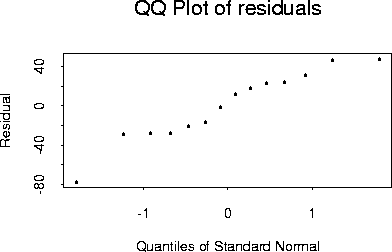STAT 330 Lecture 30
Reading for Today's Lecture: 12.1, 12.2,12.3
Goals of Today's Lecture:
Today's notes
Simple Linear Regression Model:
We assume for each observation a model equation of the form
![]()
where
Distribution theory for estimates:
![]()
and are given by
![]()
and
![]()
where
![]()
![]()
![]()
and
![]()
![]()
and
![]()
If we also assume that the errors are ![]() then
then

has a t distribution on n-2 degrees of freedom.
We can use this distribution theory to test hypotheses and give confidence intervals:
Confidence Intervals
The inequality ![]() can be solved as usual to get the
interval
can be solved as usual to get the
interval
![]()
This confidence interval, which is exact for normally distributed errors can also be used in large samples for non-normal errors.
Hypothesis Tests
We can test ![]() by computing
by computing

and getting P values from t tables. Again this test can be used
in large samples even if the errors are not normal.
The most common value for ![]() is 0. In this case
is 0. In this case

and
![]()
is the F statistic from the ANOVA table.
Residual Plots
After fitting the model you should examine residual plots. The fitted residuals are defined by
![]()
You should plot:
An experiment was conducted to relate a variable Y, the production of nitrous oxides to a variable x, the "Burner Area Liberation Rate" (a measure of energy produced per square foot of area of some burner in a power plant). The data are
| x | 100 | 125 | 125 | 150 | 150 | 200 | 200 |
| y | 150 | 140 | 180 | 210 | 190 | 320 | 280 |
| x | 250 | 250 | 300 | 300 | 350 | 400 | 400 |
| y | 400 | 430 | 440 | 390 | 600 | 610 | 670 |
Here is a plot of the data:

I used SAS to fit the regression model. In particular I used proc glm (glm stands for general linear model). Here is the SAS code:
options pagesize=60 linesize=80; data nox; infile 'ch12q9.dat'; input area emission ; proc glm data=nox; model emission = area; output out=noxfit p=yhat r=resid ; proc univariate data=noxfit plot normal; var resid; proc plot; plot resid*area; plot resid*yhat; run;The line labelled model says that I am interested in the effects of area (my shorthand name for ``Burner Area Liberation Rate'') on emissions.
The output from proc glm is
The SAS System 1
10:00 Monday, November 20, 1995
General Linear Models Procedure
Number of observations in data set = 14
The SAS System 2
10:00 Monday, November 20, 1995
General Linear Models Procedure
Dependent Variable: EMISSION
Sum of Mean
Source DF Squares Square F Value Pr > F
Model 1 398030.26093 398030.26093 294.74 0.0001
Error 12 16205.45335 1350.45445
Corrected Total 13 414235.71429
R-Square C.V. Root MSE EMISSION Mean
0.960879 10.26905 36.748530 357.85714
Source DF Type I SS Mean Square F Value Pr > F
AREA 1 398030.26093 398030.26093 294.74 0.0001
Source DF Type III SS Mean Square F Value Pr > F
AREA 1 398030.26093 398030.26093 294.74 0.0001
T for H0: Pr > |T| Std Error of
Parameter Estimate Parameter=0 Estimate
INTERCEPT -45.55190539 -1.79 0.0989 25.46779420
AREA 1.71143233 17.17 0.0001 0.09968772
The conclusions are that AREA has a very significant and strong effect on emissions, that the intercept of the linear regression might be 0 and that the estimated slope is
![]()
The diagnostic plots show one possible Y outlier at x=300
Plot of RESID*AREA. Legend: A = 1 obs, B = 2 obs, etc.
RESID |
|
60 +
|
|
|
| A A
|
40 +
|
|
| A
|
|A A
20 +
| A
|
| A
|
|
0 + A
|
|
|
|
| A
-20 + A
|
| A
| A A
|
|
-40 +
|
|
|
|
|
-60 +
|
|
|
|
| A
-80 +
|
-+-----+-----+-----+-----+-----+-----+-----+-----+-----+-----+-----+-----+
100 125 150 175 200 225 250 275 300 325 350 375 400
AREA
Here is a Q-Q plot of the residuals

Prediction Intervals
University admissions officers would like to guess a student's GPA at the end of
first year on the basis of her/his high school record. In the simplest case that
high school record might be summarized by x, the high school GPA. The mathematical
version of this problem is that there is a data set of ![]() pairs and a
new individual x for which we desire to guess the corresponding Y. A related,
but different problem is to guess the average first year GPA for a large group
of students whose high school GPA is x.
pairs and a
new individual x for which we desire to guess the corresponding Y. A related,
but different problem is to guess the average first year GPA for a large group
of students whose high school GPA is x.
We will use the following notation.
![]()
If we have fitted a simple linear regression model to our data set, obtaining
estimated slope ![]() and intercept
and intercept ![]() then we predict
both the individual and the average of the group using the regression line:
then we predict
both the individual and the average of the group using the regression line:
![]()
Next lecture we will develop the theory to get an estimate of the
likely size of the prediction error ![]() , a prediction
interval for Y (of the form
, a prediction
interval for Y (of the form ![]() ) and
a standard error and confidence interval for
) and
a standard error and confidence interval for
![]() .
.